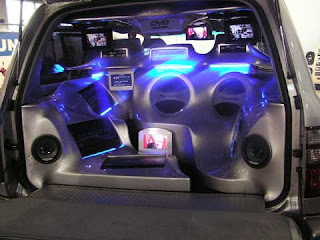The Sony Corporation, based in Tokyo is a leading manufacturer of audio, video, communications, and information technology products for the consumer and professional markets. Their music, motion picture, television, computer entertainment, and online businesses also make Sony one of the most comprehensive entertainment companies in the world.
So it is not surprising to learn that Sony car stereos are also well renowned in the automotive audio market. In 2005, Sony car stereos launched their latest carrier car audio product, the Sony car stereo Xplod series which has an amazing lineup of head units, speakers, amplifiers, subwoofers, changers and accessories. It is impressive both in performance and aesthetic value.
 |
| Sony car stereo Xplod Series |
A good head unit from the Sony car stereo Xplod Series is the CDX – M9900 CD Receiver/Changer Controller/MP3 Player which boasts these features:
- 32,000-color TFT display
- Video Input for External Source Playback
- CD/CD-R/CD-RW/MP3 playback
- 4-Volt F/R/Sub Preouts w/HPF & LPF
- 52W x 4 High Power
- CEA-2006 Power Compliant
- CD/MD Control, CD Text
- XM Ready
- BBE MP, DSO, EQ7
- Auxiliary Input
- 1-bit D/A Converter
- Drive-S with 120dB S/N Ratio
- SSIR-EXA tuner, 18FM & 12AM presets
- Red key illumination
- Supplied wireless card remote (RM-X145A)
- Optional wireless rotary remote (RM-X6S)
- Optional wired rotary remote (RM-X4S)
This Sony car stereo goes best installed with matching items from the Xplod series such as:
Sony car stereo XS – V6941H 6 x 9” 4 - Way Speakers:
- 6 x 9" HOP Woofer Cone
- Stroke Stabilizer Surround
- 2-5/8" Cone Mid
- 1" Balanced Dome PEI Tweeter, Super Tweeter
- 400W Peak Power (100W RMS)
- Flexible Mounting Options
Sony car stereo XM-2100GTX 2/1 Channel Amplifier:
- 600W Max Power
- 100W x 2 RMS into 4 ohms, 20Hz-20kHz @ 0.04% THD
- 250W x 1 RMS into 4 ohms, 20Hz-20kHz @ 0.1% THD
- CEA-2006 Power Compliant
- Variable 50 - 300 Hz low pass filter
- 40 Hz EQ boost
- MOSFET power supply
- RCA & speaker level inputs
Sony car stereo XS-L102P5 10” Subwoofer:
- 10" Polypropylene Cone
- 1200W Peak Power (330W RMS)
- Unique cone design offers superior rigidity
- Gold-plated Binding Posts
- Small sealed/bandpass enclosure optimized
- 4-Ohm Voice Coil
- 2005 Subwoofer Parameters
Like other modern car audio manufacturers, the Sony car stereo also offers video capable units for playing VCDs, DVDs. A good item from the Sony car stereo Dream System Series is the MV - 900SDS Mobile DVD Dream System.
- 9" wide screen TFT display with swivel function
- DVD/CD-R/RW/VCD/MP3 Playback
- Built-in wired FM modulator
- Reversible display image
- Slot-load DVD Mechanism
- Memory Stick® media for playback of JPEG, MPEG, MP3
- Built-in Stereo Speakers
- A/V Input
- A/V Output
- Optical Digital Output (Dolby Digital®, dts®)
- IR transmitter for wireless headphones
- 2 sets of wireless headphones included
- Wireless card remote included
This unit is encased in a grey metallic finish and is ideally attached on the ceiling of the vehicle.
It is also an amazing fact that a lot of enthusiasts also incorporate the PlayStation into their Sony car stereos, which is probably one of the reasons why the Sony car stereo system has earned quite a following.























